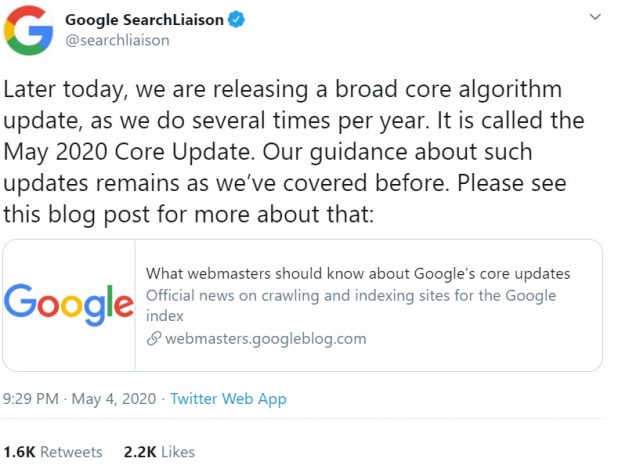On May 4 this year, Google announced a new algorithm update. It’s a core update, which, in layman’s terms means it’s a BIG one.

We have more signals that this is a big update, whose effects we’ll be analyzing for a long time. Moz uses a proprietary system (MozCast Temperature) to decide which updates are the hottest.
We can easily tell that this is the biggest algorithm change since Medic back in 2018.
Rank Ranger’s Mordy Oberstein called the May update “an absolute monster.” “The January update was a very big update yet this one slightly edges it out”, he says.
OK, now that we know that all the experts in the industry agree that it’s a BIG update, let’s get to the practical stuff.
Did you log into your Google Analytics Account or into your Google Search Console recently? Has your traffic changed? Has your traffic increased or decreased? If it’s the latter, don’t fret. I’ve got some pointers to help you recover – you’ll find them further below.
So, What Changed?
Great question! It appears that very few things actually changed. But they had a big impact.
As always, Google isn’t very generous with the details when it comes to how their updates affect websites. Luckily, the SEO community is hard at work whenever a new update hits and we’ve been able to infer some things:
- Thin content gets penalized and demoted (more on that below)
- Negative link velocity means dropping websites (link velocity is the speed with which a website acquires backlinks. Negative link velocity means a website loses links faster than it can replace them). This is an assumption made by Cristoph C. Cemper of Link Research Tools. Personally, I disagree with it for two reasons: first off, it’s based on anecdotal evidence only. Second – see below:
- Thin content supported only by backlinks drops like mad. This means that content that’s short, poor quality and doesn’t cover the topic extensively loses rankings despite being supported by backlinks. Again, authority content is the winner, especially in competitive areas!
- Local SERPs are still undergoing major changes. However, this started before the update was rolled out.
- Directories have seen some ranking growth and so have aggregators.
Which Are the Most Affected Industries?
As you may know, not all industries are hit the same way by a core update. Ever since Google published the EAT and YMYL guidelines, it has been clear that each update will affect industries differently.
It’s important to note, though, that core updates don’t happen in a void. On May 4th, the COVID-19 pandemic was still running strong and getting interest from everyone. This may explain some of these fluctuations and why, News, for instance, saw very little of that.
It’s still early to distinguish correlation from causation. But we have also seen major media outlets like the NY Post lose rankings after this update, which may have more to do with thin content on some pages backed only by backlinks.
Does the Pandemic Have Anything to do with it?
Definitely! We have never seen such a big shift in interests across the globe. All of a sudden everyone everywhere became more interested in hearing the news and learning medical facts.
There have also been understandable drops in rankings for gyms, beauty parlors, cinemas, restaurants that do not offer take-out and…pretty much everything that has been shut down pretty much everywhere.
Most of these industries will probably bounce back easily (at least in terms of search rankings) as soon as things really go back to normal.
Have You Been Hit by the Update? Here’s How to Recover
Let me be honest: the week of the update, I was completely unaware of it. There were major changes in our agency’s staffing and I had to pick up a lot of slack.
I found about it later than I’d like to admit, from the SEO communities I’m in.
But there’s some good news here: our rankings have NOT dropped! In fact, we’ve seen a substantial increase in terms ranked and even CTR on both agency websites I manage, Idunn and Copywritech.
Why?
Because we never put out thin content.
Remember what I said in the first part of this article about thin content backed by links being penalized? Well, that was not our case. We’ve also checked in with the clients we do SEO content for and they haven’t been hit either, even if they are in diverse industries.
I call that a major win!
It proves once again that I’ve been right to insist that only great content should be published, both for my agencies and for our clients.
If you need more proof, Google says the same thing about recovery after a core update: work on your content!
So, here’s your actionable plan:
- Update your old content. Outdated links, stats, thin content that doesn’t cover a topic extensively – all these should be nixed and replaced with content that meets user needs and Google’s standards (luckily, they are one and the same thing!)
- Keep publishing content regularly. Invest in long-form content that’s well-written and well-researched. Don’t make assumptions in your content, back all your claims with data!
- Disavow spam links. Yes, you will lose some links and end up with negative link velocity. But with the current emphasis on a ‘clean’ internet, that’s preferable to having spammy websites link to your domain.
- Optimize for keywords that are tied with user intent. Forget about keyword search volume. You don’t need a million hits from people who won’t buy anything from you. You need 100 hits from people who are ready to buy.
That’s it!
As Google puts it, there’s not a lot you can do. But you CAN (and should!) ensure that your content is valuable for your readers and for your business goals.
Not sure how to do that? No problem! That’s what my agency specializes in! We’ve helped dozens of clients rank for relevant keywords and get leads and conversions – all through SEO content. Check out our case studies to see how we’ve done it and drop us a line if you need help with SEO content that ranks and converts.





